Abstract
The cellular fatty acid profiles of newly described campylobacters were determined on a polar, capillary column. Six isolates of the gastric spiral organism, Campylobacter pylori subsp. mustelae, from ferrets from Australia, England, and the United States were all found to have a similar fatty acid profile which was different from that of C. pylori from humans; C. pylori subsp. mustelae did not have 3-hydroxyoctadecanoic acid (3-OH C18:0) and had much less tetradecanoic acid (C14:0) and much more hexadecanoic acid (C16:0). Inasmuch as Lambert et al. (M.A. Lambert, C.M. Patton, T.J. Barrett, and C.W. Moss, J. Clin. Microbiol. 25:706-713, 1987) have proposed that campylobacters can be grouped by cellular fatty acid composition, we propose this organism should be in a new gas-liquid chromatography (GLC) group, group J. Seven isolates of gastric spiral organisms from macaque monkeys and baboons, including three from Macaca nemestrina, and one isolate from a pig were found to have fatty acid profiles very similar to that of C. pylori; but a second type of organism (type B) from M. nemestrina had a unique profile without 19-carbon cyclopropane fatty acid (C19:0 cyc) but with 3-hydroxy tetradecanoic acid (OH C14:0), which is not present in other gastric spiral bacteria. We propose that this organism (nemestrina type B) should be in a new GLC group, group K. The cellular fatty acid profile of seven isolates of C. jejuni subsp. doylei was found to be similar to that for C. jejuni, but with possibly significant differences in that the former did not have 3-OH C14:0 but did have 3-hydroxyhexadecanoic acid (3-OH C16:0) and had more C14:0 than did C. jejuni. Two strains of urease-positive thermophilic campylobacters were found to have a profile similar to that of "C. cinaedi" and thus should be included with them in GLC group D. We confirm that C. sputorum has a unique cellular fatty acid composition and suggest that it should be in a new group, group H.
Full text
PDF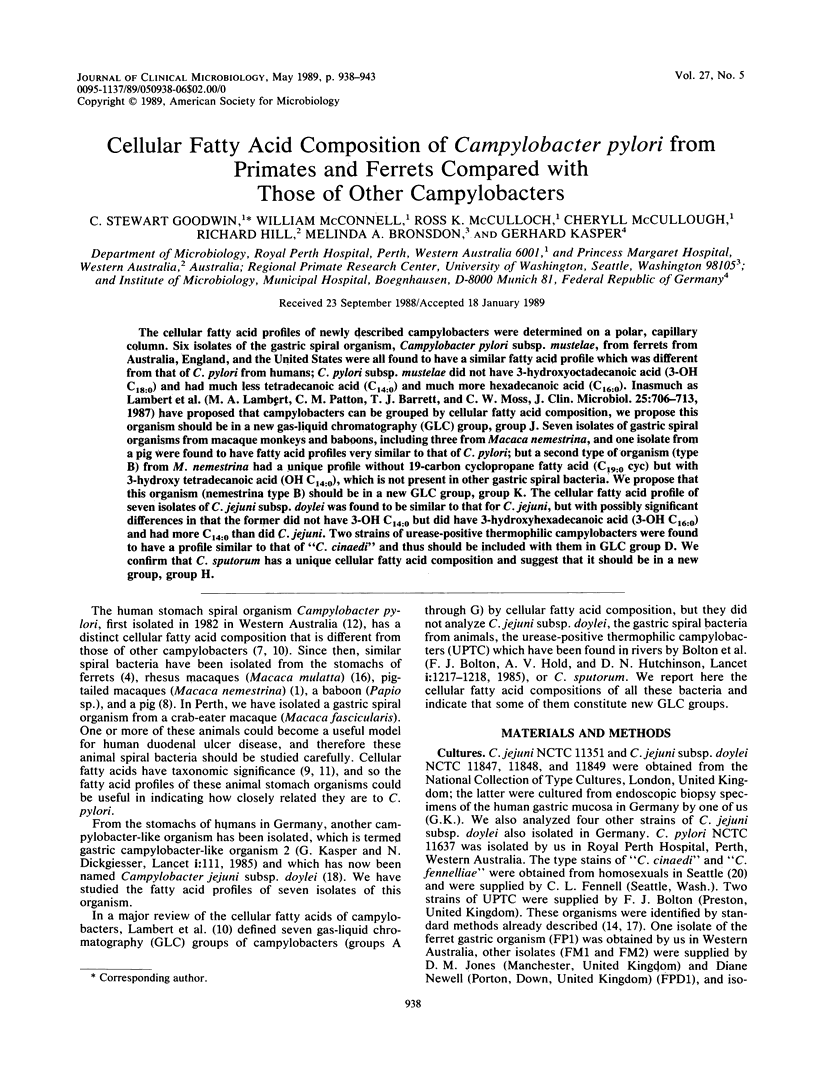
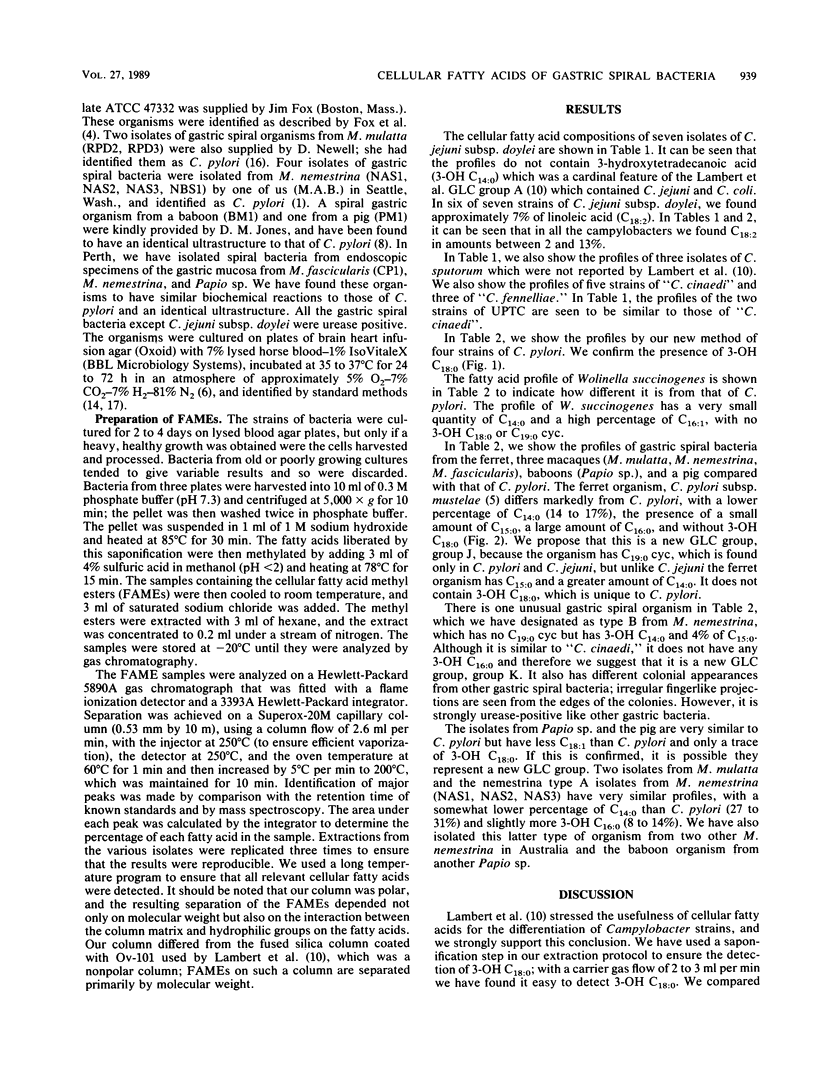
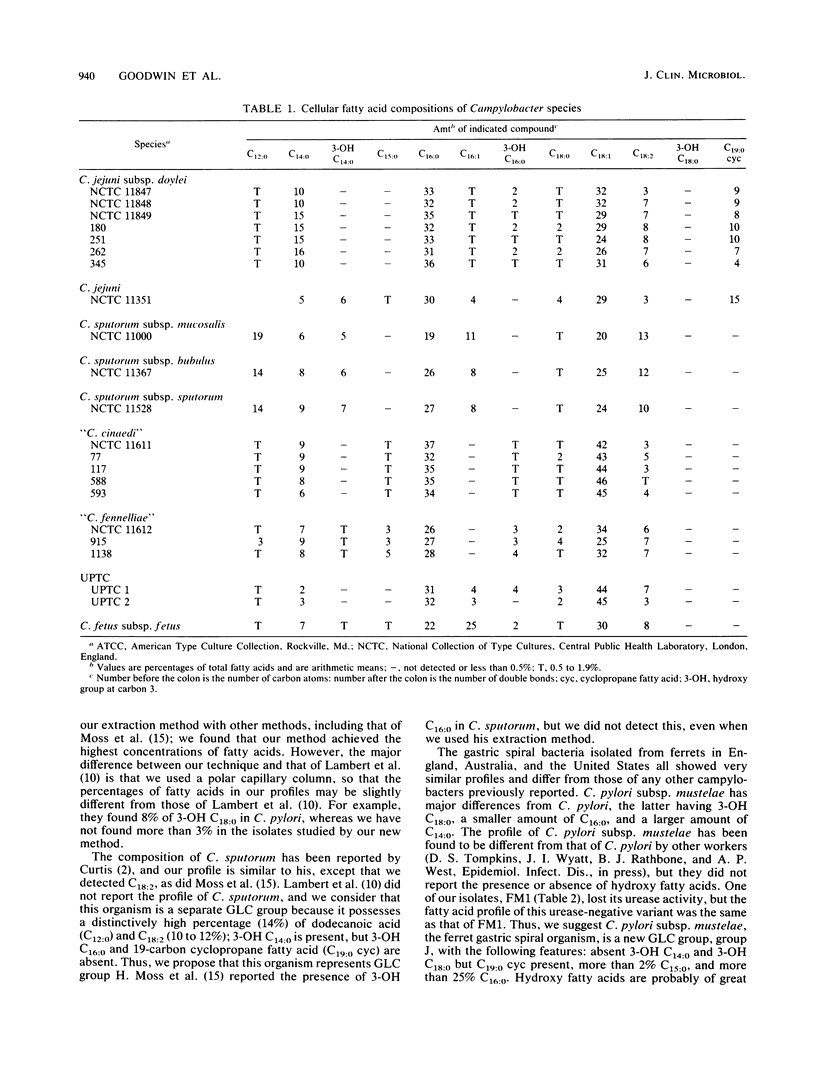
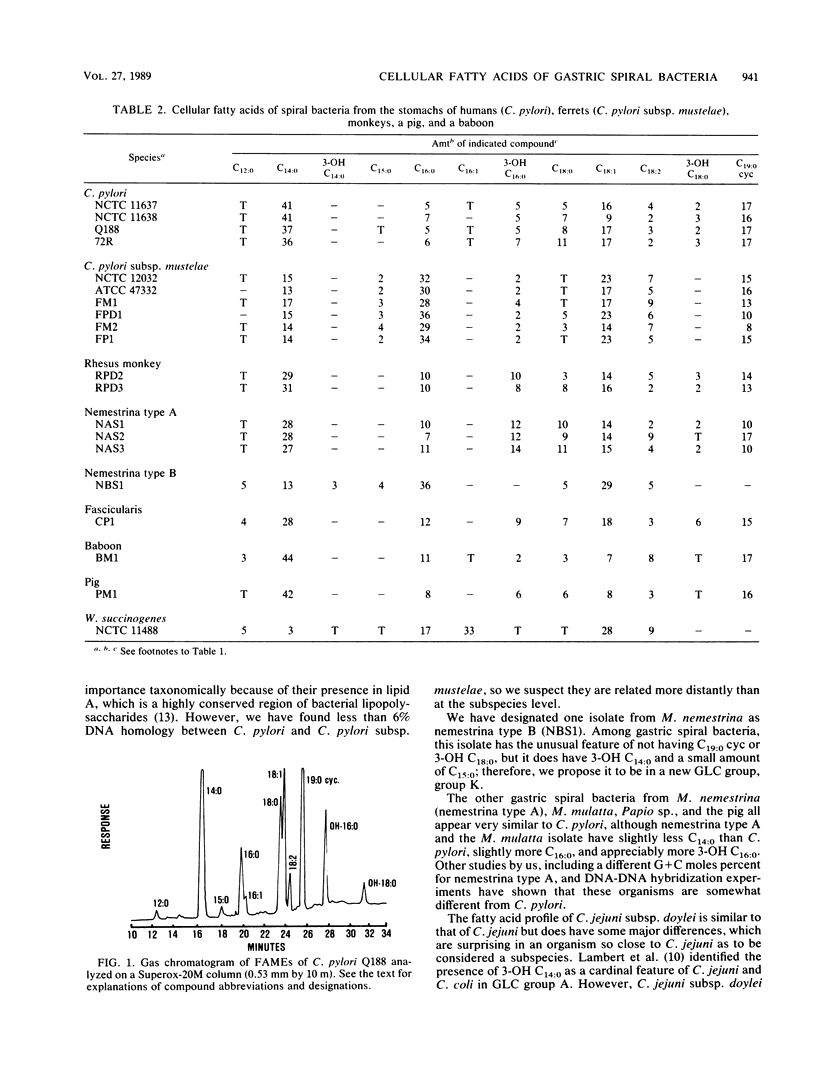
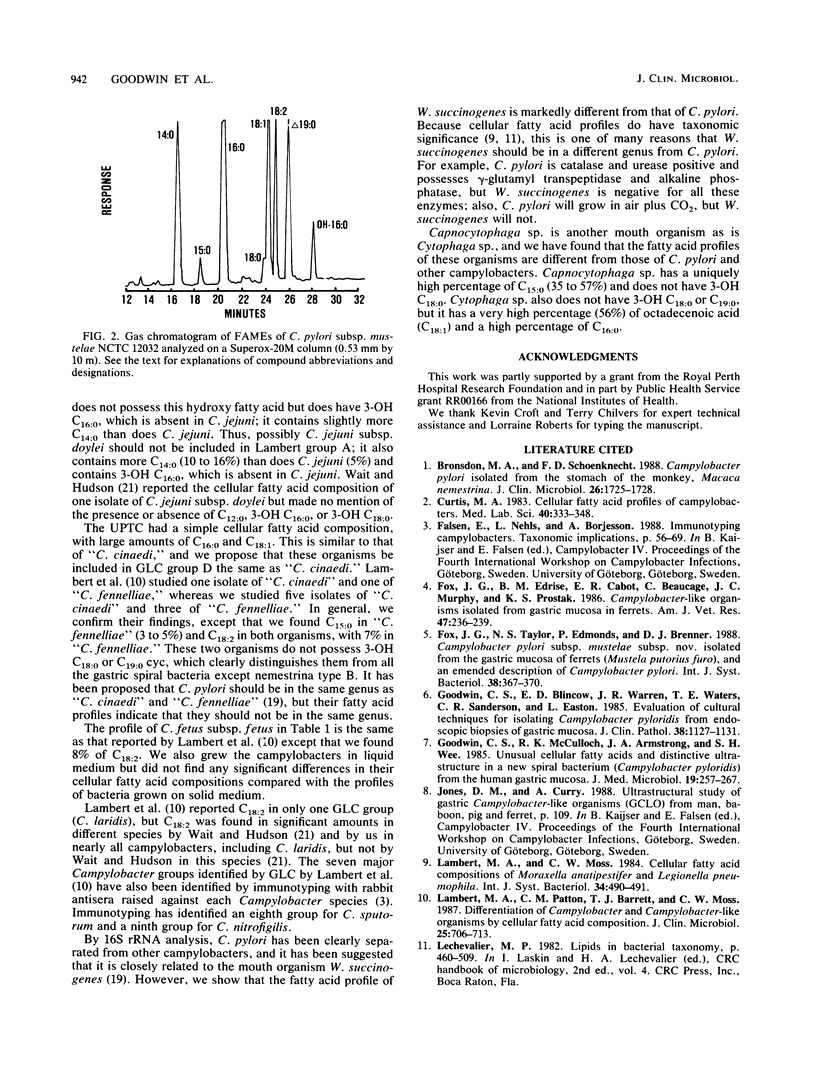
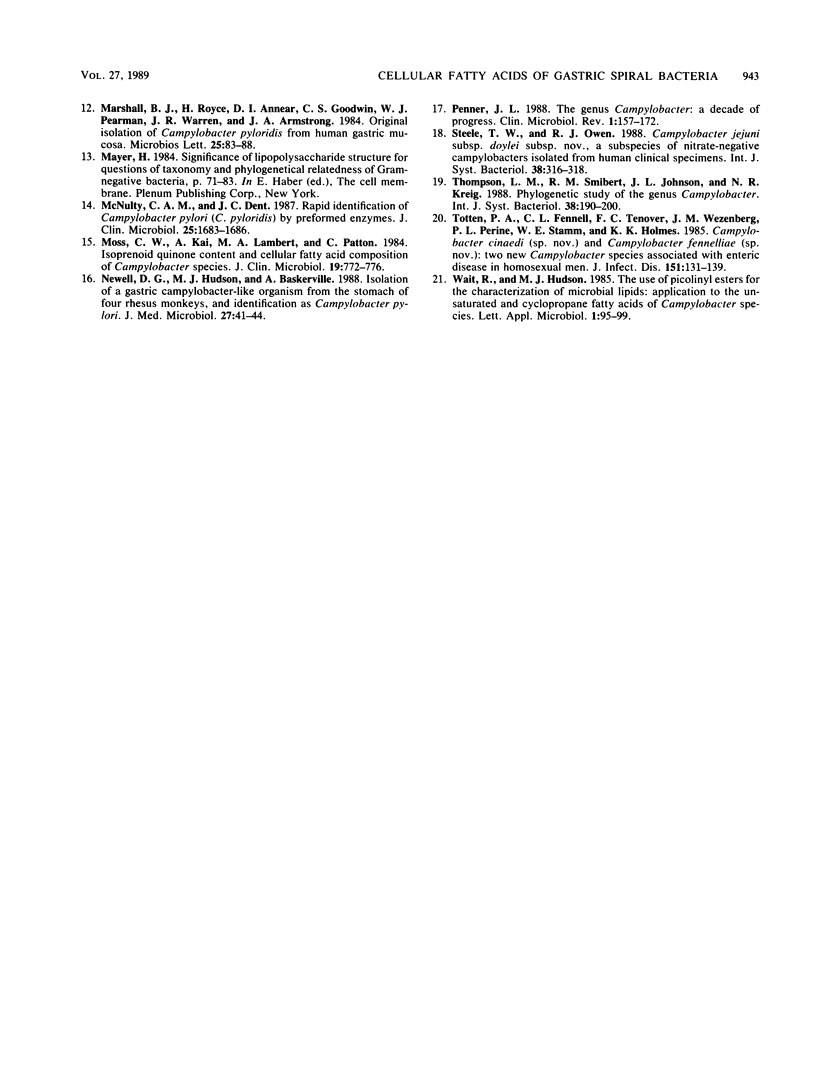
Selected References
These references are in PubMed. This may not be the complete list of references from this article.
- Bronsdon M. A., Schoenknecht F. D. Campylobacter pylori isolated from the stomach of the monkey, Macaca nemestrina. J Clin Microbiol. 1988 Sep;26(9):1725–1728. doi: 10.1128/jcm.26.9.1725-1728.1988. [DOI] [PMC free article] [PubMed] [Google Scholar]
- Curtis M. A. Cellular fatty acid profiles of campylobacters. Med Lab Sci. 1983 Oct;40(4):333–348. [PubMed] [Google Scholar]
- Fox J. G., Edrise B. M., Cabot E. B., Beaucage C., Murphy J. C., Prostak K. S. Campylobacter-like organisms isolated from gastric mucosa of ferrets. Am J Vet Res. 1986 Feb;47(2):236–239. [PubMed] [Google Scholar]
- Goodwin C. S., Blincow E. D., Warren J. R., Waters T. E., Sanderson C. R., Easton L. Evaluation of cultural techniques for isolating Campylobacter pyloridis from endoscopic biopsies of gastric mucosa. J Clin Pathol. 1985 Oct;38(10):1127–1131. doi: 10.1136/jcp.38.10.1127. [DOI] [PMC free article] [PubMed] [Google Scholar]
- Goodwin C. S., McCulloch R. K., Armstrong J. A., Wee S. H. Unusual cellular fatty acids and distinctive ultrastructure in a new spiral bacterium (Campylobacter pyloridis) from the human gastric mucosa. J Med Microbiol. 1985 Apr;19(2):257–267. doi: 10.1099/00222615-19-2-257. [DOI] [PubMed] [Google Scholar]
- Lambert M. A., Patton C. M., Barrett T. J., Moss C. W. Differentiation of Campylobacter and Campylobacter-like organisms by cellular fatty acid composition. J Clin Microbiol. 1987 Apr;25(4):706–713. doi: 10.1128/jcm.25.4.706-713.1987. [DOI] [PMC free article] [PubMed] [Google Scholar]
- McNulty C. A., Dent J. C. Rapid identification of Campylobacter pylori (C. pyloridis) by preformed enzymes. J Clin Microbiol. 1987 Sep;25(9):1683–1686. doi: 10.1128/jcm.25.9.1683-1686.1987. [DOI] [PMC free article] [PubMed] [Google Scholar]
- Moss C. W., Kai A., Lambert M. A., Patton C. Isoprenoid quinone content and cellular fatty acid composition of Campylobacter species. J Clin Microbiol. 1984 Jun;19(6):772–776. doi: 10.1128/jcm.19.6.772-776.1984. [DOI] [PMC free article] [PubMed] [Google Scholar]
- Newell D. G., Hudson M. J., Baskerville A. Isolation of a gastric campylobacter-like organism from the stomach of four rhesus monkeys, and identification as Campylobacter pylori. J Med Microbiol. 1988 Sep;27(1):41–44. doi: 10.1099/00222615-27-1-41. [DOI] [PubMed] [Google Scholar]
- Penner J. L. The genus Campylobacter: a decade of progress. Clin Microbiol Rev. 1988 Apr;1(2):157–172. doi: 10.1128/cmr.1.2.157. [DOI] [PMC free article] [PubMed] [Google Scholar]
- Totten P. A., Fennell C. L., Tenover F. C., Wezenberg J. M., Perine P. L., Stamm W. E., Holmes K. K. Campylobacter cinaedi (sp. nov.) and Campylobacter fennelliae (sp. nov.): two new Campylobacter species associated with enteric disease in homosexual men. J Infect Dis. 1985 Jan;151(1):131–139. doi: 10.1093/infdis/151.1.131. [DOI] [PubMed] [Google Scholar]


